Introduction of AFT delegate's job... A first look at the national union convention of 2010
Consider this article the "American Federation of Teachers (AFT) 2010 Convention Primer, Level 101: The Delegates’ Job – Approving of Constitutional Resolutions Pre-Selected by the Leaders". Author credit: By Susan L. Zupan, Rookie Convention Delegate, Chicago Teachers Union (CTU), Local 1. I hope that every new delegate to a national convention gets something like this. The AFT conventions are held at various locations around the country, according to AFT officials, who explained that the locations are usually rotated for some regional balance. The next AFT convention, in 2012, will be held in Detroit.
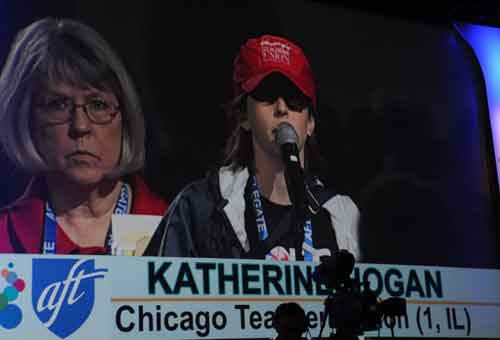 More than a dozen delegates from CTU Local 1 took the floor during the debates over the resolutions presented to the convention. Above, Karie Hogan of Little Village High School School of Social Justice is projected on to the big screen during her remarks. On many occasions, Chicago's delegates were speaking in opposition to New York City's massive United Federation of Teachers delegation, which frowned on Chicago's independence from Randi Weingarten's political machine. Chicago delegates quickly came to know that members of Weingarten's "Progressive Caucus" were looking over their shoulders throughout the convention. Substance photo by George N. Schmidt.Every two years, our local union, the Chicago Teachers Union (CTU, Local 1 of the AFT) joins other AFT locals and affiliates at a national convention to debate union policy, hear from national speakers about issues related to the union and the union's members, and learn. In July 2008, the convention was held at Navy Pier in Chicago. At that time, the Chicago delegates were members (or former members) of the United Progressive Caucus (UPC), headed by then CTU president Marilyn Stewart. CORE (Chicago's Caucus of Rank and File Educators) had just been founded, and a few people from CORE attended the convention, some leafleting on some of the issues.
More than a dozen delegates from CTU Local 1 took the floor during the debates over the resolutions presented to the convention. Above, Karie Hogan of Little Village High School School of Social Justice is projected on to the big screen during her remarks. On many occasions, Chicago's delegates were speaking in opposition to New York City's massive United Federation of Teachers delegation, which frowned on Chicago's independence from Randi Weingarten's political machine. Chicago delegates quickly came to know that members of Weingarten's "Progressive Caucus" were looking over their shoulders throughout the convention. Substance photo by George N. Schmidt.Every two years, our local union, the Chicago Teachers Union (CTU, Local 1 of the AFT) joins other AFT locals and affiliates at a national convention to debate union policy, hear from national speakers about issues related to the union and the union's members, and learn. In July 2008, the convention was held at Navy Pier in Chicago. At that time, the Chicago delegates were members (or former members) of the United Progressive Caucus (UPC), headed by then CTU president Marilyn Stewart. CORE (Chicago's Caucus of Rank and File Educators) had just been founded, and a few people from CORE attended the convention, some leafleting on some of the issues.
By July 2010, a lot had changed in Chicago. The CORE slate had been elected to lead the Chicago Teachers Union in the June 11 runoff. This year the national convention was held in Seattle, Washington from July 7 to July 11, 2010. The milestone of reaching 1.5 million members was celebrated by the AFT. In contrast, the National Education Association (NEA), the other national teachers union, has 3.2 million members. Most of the CORE delegates, headed towards the national AFT convention, were rookies, meaning that we had never been to a national union convention, let alone as delegates with the responsibility to represent the members of the CTU.
Having just been elected on June 11, with less than one month to make all the traveling arrangements and attempt to do their union homework, 104 newly elected CTU delegates from the CORE (Caucus of Rank and File Educators) Caucus along with 4 veteran CTU delegates from the UPC (United Progressive Caucus) Caucus attended the convention. For most, it was a crash course in national unionism. Although the total number of delegates Chicago could have sent was 150, only 108 were in Seattle for the convention.
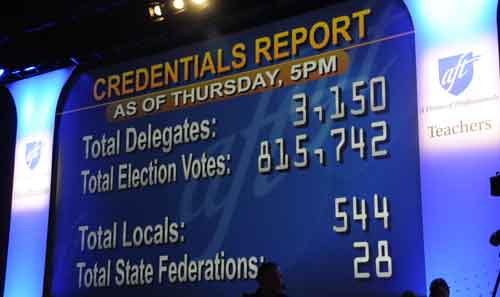 Every morning, the Credential Committee reports to the convention. By the final day of business, more than 3,400 delegates were registered. Above, the first Credentials Committee report on the morning of Friday (July 9, 2010), reflected who had been registered as of the end of business on Thursday. Substance photo by George N. Schmidt.Prior to this convention, a few of the newly elected delegates from the CORE caucus had attended previous AFT conventions, having been members of the PACT (ProActive Chicago Teachers and School Employees) Caucus or the United Progressive Caucus (UPC), Marilyn Stewart's caucus.
Every morning, the Credential Committee reports to the convention. By the final day of business, more than 3,400 delegates were registered. Above, the first Credentials Committee report on the morning of Friday (July 9, 2010), reflected who had been registered as of the end of business on Thursday. Substance photo by George N. Schmidt.Prior to this convention, a few of the newly elected delegates from the CORE caucus had attended previous AFT conventions, having been members of the PACT (ProActive Chicago Teachers and School Employees) Caucus or the United Progressive Caucus (UPC), Marilyn Stewart's caucus.
A meeting was called in which this veteran group assisted the rookies by sharing their convention-attending experiences and answering questions. Everything from the point of election was on short notice for Chicago’s newly-elected AFT delegation, but they did a phenomenal job.
NOTE: A large portion of what follows describes the experience of being a conscientious rookie delegate along with a broad overview of how submitted resolutions become accepted, official, AFT constitutional resolutions. The final portion presents an analysis of data in an attempt to determine the level of orchestration of the convention by the leaders. For those who are already familiar with the delegate’s role and the resolution process, or for those who simply wish to get to the meat and potatoes of the data analysis right now, please scroll down to the Question & Answer section.
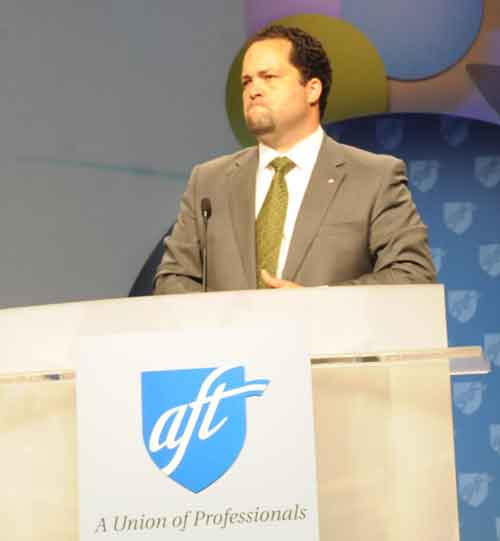 More than a dozen major speakers in addition to the controversial Bill Gates spoke to the convention. Above, NAACP national chairman Ben Jealous called on the delegates to join in a March on Washington on October 2, 2010. Most of the featured speakers, including two U.S. Senators, delivered very polished speeches. Substance photo by George N. Schmidt.The first and major thing we received as delegates was a 145-page “booklet” (henceforth to be referred to as a book) entitled 2010 Proposed AFT Constitutional Amendments and Resolutions. The major subheadings on the Table of Contents read as follows:
More than a dozen major speakers in addition to the controversial Bill Gates spoke to the convention. Above, NAACP national chairman Ben Jealous called on the delegates to join in a March on Washington on October 2, 2010. Most of the featured speakers, including two U.S. Senators, delivered very polished speeches. Substance photo by George N. Schmidt.The first and major thing we received as delegates was a 145-page “booklet” (henceforth to be referred to as a book) entitled 2010 Proposed AFT Constitutional Amendments and Resolutions. The major subheadings on the Table of Contents read as follows:
Rules of Conduct for the 2010 Convention
Roberts’ Rules At a Glance (back cover)
Constitutional Amendments and Convention Committee *with two subheadings: Constitution and Bylaws
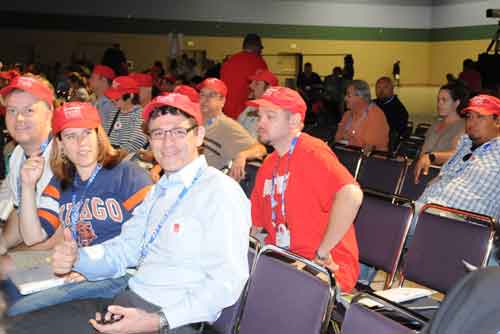 At various times during the convention, it was difficult to find seats. Above, some of the members of the Chicago Teachers Union delegation (including Jim Cavallero, Danielle Ciesielski, Jesse Sharkey, and Joey McDermott) during the convention business were seated at the very back of the hall. Substance photo by George N. Schmidt. Educational Issues Committee
At various times during the convention, it was difficult to find seats. Above, some of the members of the Chicago Teachers Union delegation (including Jim Cavallero, Danielle Ciesielski, Jesse Sharkey, and Joey McDermott) during the convention business were seated at the very back of the hall. Substance photo by George N. Schmidt. Educational Issues Committee
Healthcare Committee
Higher Education Committee
Human Rights Committee
International Relations Committee
Labor and the Economy Committee
Organizing and Collective Bargaining Committee
Political Action/Legislation Committee
Public Services Committee
Retirement Committee
Schools and Colleges Support Staff Issues Committee
Women’s Rights Committee
Prior to receiving the book, one of the first things each delegate was asked to do was select and rank his/her first, second, and third committee choices from a supplied list. On the first day of the convention, I found out that I was on the first committee I had chosen — the Educational Issues Committee.
I’m not sure if other delegates were as fortunate. A day or two before the convention, we were given a Washington, D.C. phone number to call to find out our committee assignment in advance. I got an answering machine, hung up, and didn’t try again. Others reported success, but most, I think, as me, were too busy making all the other arrangements necessary (family/kids, dogs/cats, transportation, packing…) for being away for almost a week on the other side of the country. So we found out what committee we were on by looking on the backs of our delegates’ badges when finally registering in Seattle.
Back to the book. Under the committees listed above, 82 proposed constitutional resolutions that were submitted to the national union leaders from affiliates across the United States are categorized and listed. In the pages that follow, the complete text of each resolution is printed along with the name of the submitting affiliate. One of the first things I noticed with a cursory glance under the committee subheadings was that the resolutions submitted from the AFT Executive Council were listed first.
The AFT Executive Council submitted resolutions for all but 4 of the 13 committees: Organizing and Collective Bargaining Committee, Political Action/Legislation Committee, Retirement Committee, and Women’s Rights Committee. (Why would anyone expect national union leaders to submit new ideas in these categories, right?)
When I started to dig in and read, it was like this quote from page 1 for the first 6 pages under the subtitle “Constitutional Amendments and Convention Committee”: “(d) Employees earning under $8,500: Such locals pay per capita tax for such members at one eighth the regular rate.” And that particular part is underlined to indicate it is “proposed new language” (with no context surrounding it).
While reading, it is understandable that normal brain functioning started to shut or melt down from the experience. On the other hand, if someone decided to open the book and glance to the middle for a look-see, on the page I randomly opened to while writing this one can read: “WHEREAS, this Entitlement Commission is composed of presidential appointees as well as members of both political parties from the Senate and House of Representatives; and…” I’m betting a good chunk of delegates across the nation just tossed the book. I personally made it through the first 6 pages, with a very teensy bit of comprehension along with the beginnings of a stress headache, then, believe it or not, some of the reading actually got good! At the very end of “Bylaws,” RESOLUTION 1 entitled “Progressive Caucus Discipline” states: “WHEREAS, such ‘discipline’ violates the principle of democratically and openly conducting our union’s business on the floor of the convention…” And RESOLUTION 2 entitled “Put Locals’ Concerns First” states: “WHEREAS, locals have learned that filing resolutions is usually wasted effort…” Hot damn! The plot thickens with something closer to English! Shout out to Administrative and Residual Employees Union, Local 4200!
After being published in the book, the fate of all the proposed constitutional resolutions sent in to the national leaders from the affiliates across the United States lies in the hands of the above-listed committees, where, thanks to reading all of RESOLUTION 2, I learned “each committee is permitted to report out only three resolutions.” This structure was luckiest for the Retirement and Women’s Rights Committees, since they each had only three resolutions to consider so all could conceivably be sent to “the floor” (“the floor” being the delegates all put back together again after being separated into committees).
In contrast, this structure of choosing only three resolutions was unluckiest for the International Relations Committee, since this committee had 11 resolutions to consider. However, I counted 16 separate resolutions submitted by different affiliates that were related or almost the same; and these were in fact combined during the committee process. For example, from the International Relations Committee, it appears that 3 resolutions regarding Afghanistan were combined more-or-less into one by that committee prior to submission to the floor.
While it seems unjust for only 3 resolutions per committee to make the cut, for the floor to consider all of the resolutions submitted, the convention itself would have to be much lengthier, and I’m betting people wouldn’t go for that. So the key question then becomes: which resolutions make the cut?
Prior to attending, one of the statements I repeatedly heard about the AFT convention was that it was “heavily controlled.” Trusting but wanting to verify this statement for myself was something I sought to do while in attendance at the convention and afterward via follow-up data analysis/research. My conclusion: It is very true. But if someone asks me now, my response will be, “It is heavily controlled - with an interesting illusion of participation.”
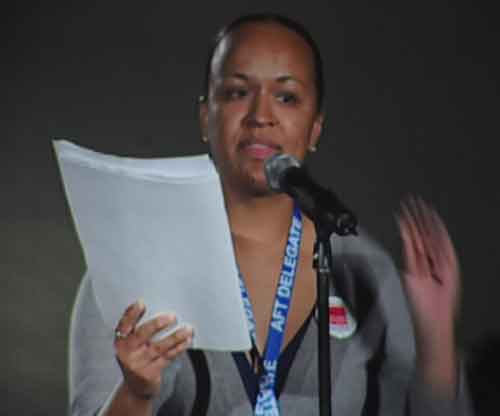 In addition to helping shape a major convention resolution, Chicago Teachers Union delegate Jen Johnson spoke forcefully in support of it. Substance photo by George N. Schmidt.A small example of the control of the process can be observed by following the outcomes for RESOLUTIONS 1 and 2 (referred to above as “English”). I’m sorry but am not surprised to report that neither of these resolutions, each in a different way attempting to democratize the national AFT, made it out of the Constitutional Amendments and Convention Committee. RESOLUTION #1 was tagged: “Committee rules out of order.” And RESOLUTION #2 was tagged: “Committee recommends non-concurrence.” In English: they were filed in the circular file. (Amazingly and impressively, we were given two booklets within the next two days – Volume I on the first, and Volume 2 on the second - that listed the outcomes for every resolution in the respective committees, including where necessary the added amendments and/or substitutions to the original language, as well as the ranking order, with positions 1, 2, and 3 being the significant positions for resolution survival.)
In addition to helping shape a major convention resolution, Chicago Teachers Union delegate Jen Johnson spoke forcefully in support of it. Substance photo by George N. Schmidt.A small example of the control of the process can be observed by following the outcomes for RESOLUTIONS 1 and 2 (referred to above as “English”). I’m sorry but am not surprised to report that neither of these resolutions, each in a different way attempting to democratize the national AFT, made it out of the Constitutional Amendments and Convention Committee. RESOLUTION #1 was tagged: “Committee rules out of order.” And RESOLUTION #2 was tagged: “Committee recommends non-concurrence.” In English: they were filed in the circular file. (Amazingly and impressively, we were given two booklets within the next two days – Volume I on the first, and Volume 2 on the second - that listed the outcomes for every resolution in the respective committees, including where necessary the added amendments and/or substitutions to the original language, as well as the ranking order, with positions 1, 2, and 3 being the significant positions for resolution survival.)
Finally, for this 101-level AFT Convention Primer, I’d like to share, in the form of Question & Answer, a bit of data analysis I completed to attempt to determine the level of orchestration of the convention by its leaders. (NOTE: I double-checked my own numbers, and in some cases determined totals as best I could - for example, if the Progressive Caucus recommended 5 resolutions and 3 made it out of committee, I considered that a 100% success rate since only 3 could possibly make it out of committee in the first place. The basic numbers say enough, and I believe an error here or there would not greatly impact the results.)
Data Analysis Question & Answer:
Question 1: What was the total number of resolutions submitted by the AFT Executive Council compared to the number submitted by local affiliates?
Answer: The AFT Executive Council submitted 12 resolutions, 15% of the 82 in total. Local affiliates submitted 70, 85% of the total.
Question 2: What percentage of the AFT Executive Council’s resolutions passed through the various committees without any changes (amendments or substitutions) compared to those submitted by local affiliates?
Answer: 75% (9 of the 12) of the AFT Executive Council’s resolutions passed through the committees without any changes. 41% (29 of the 70) of the local affiliates’ resolutions passed through unscathed. Two of the AFT Executive Council’s resolutions were 6 pages long and not a word of them was altered.
Question 3: How many of the AFT Executive Council’s resolutions were outright “rejected” by the committees (recommending “non-concurrence,” “referral to Executive Council,” “out of order,” or “tabled”) compared to the number rejected from the local affiliates?
Answer: None of the AFT Executive Council’s resolutions were rejected. 9 (13%) of the local affiliates’ resolutions were rejected.
Question 4: How many of the 82 proposed constitutional resolutions passed out of committees to the floor for consideration by being ranked first, second, and third? Answer: 36 or 44%. This does not mean that these 36 resolutions were still intact with their original content and intent. Question 5: Of those 36, what percentage was from the AFT Executive Council compared to the local affiliates?
Answer: 10 (38%) of the 36 were from the original 12 submitted by AFT Executive Council. 26 (72%) of the 36 were from the 70 submitted by local affiliates. 83% of the AFT Executive Council’s resolutions made it to the floor compared with 37% of the local affiliates’. Conclusion: The AFT organization, whose leader repeatedly told the convention audience about how we should not accept any “top-down” educational policies being put upon us by others, is ironically and hypocritically run in a top-down fashion. And in more ways than this one, I observed over the course of the convention that the AFT leadership personifies the pot calling the kettle black regarding the “attacks’ we face as public school or public service personnel. Further Study: During the convention I stumbled upon a sheet entitled (in part) “Progressive Caucus” and “Recommended Positions on 2010 Proposed Convention Resolutions.” I also found a similar sheet from a local affiliate. There is absolutely nothing wrong with any group or caucus analyzing the resolutions to determine their significance or value to its members. In fact, CTU/CORE tried but did not have time to fully complete such a task. However, because the Progressive Caucus (PC) is the leading national union caucus of the AFT - and for those of us from Chicago, the former leaders of the CTU, Marilyn Stewart & Company, belong to the United Progressive Caucus (UPC) under that national umbrella - I was curious to determine what happened to the resolutions the PC national leaders recommended (according to the sheet I found) to their local affiliates, a majority of those present at the convention. The following questions and answers are the result of that analysis:
Question 6: How many resolutions submitted by the AFT Executive Council were recommended by the PC leadership?
Answer: All but one or 92%. (The numbers generally reflect that PC recommendations were split about 50/50 in support of resolutions from the AFT Executive Council and resolutions submitted by local affiliates; keep in mind that the AFT Executive Council did not submit resolutions to four of the committees.)
Question 7: How many resolutions that were not recommended by the PC leadership were able to make it through committees to the floor for consideration? Answer: In some cases, the PC leadership recommended less than three resolutions under committee categories, leaving one or two positions open for the committee to fill. Due in part to this, 14 resolutions (or 17% of the 82 originally submitted resolutions) not particularly recommended by PC leadership made it to the floor.
*Question 8: How many resolutions made it out of committee for consideration by the floor instead of/in the place of a resolution recommended by the PC leadership?
*Answer: A grand total of: 2. Remarkably, the rookies from CTU/CORE played a big role in one of them. CTU members can be very proud of their union’s representation at the 2010 AFT convention.
Question 9: How did the rookies do it? Answer: Some of this has been reported in other articles in this publication: substancenews.net. (I may try to write up an additional report if time permits.)
Question 10: What were the two resolutions that got past the leadership screening process, what were some of the other submitted resolutions (accepted or rejected), and how were some resolutions changed (amended or substituted) before going to the floor for consideration?
Answer: (See answer for question #9 above.)
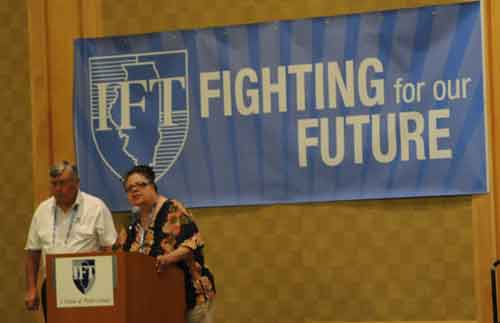 Chicago Teachers Union President Karen Lewis spoke many times during the convention, both during the debates in the general sessions and at the daily breakfasts of the Illinois Federation of Teachers. One of the highlights of the convention for Chicago was when Lewis received the second highest number of votes for AFT vice president (one of 43 vice presidents elected to the AFT executive council) in the election. The majority of the members of the Chicago delegation refused to join the Progressive Caucus, but Lewis and Michael Brunson (CTU recording secretary) did, so Lewis could be slated for an executive council seat. Above, Lewis speaks to the breakfast while Geppart looks on. Substance photo by George N. Schmidt.FINAL REVIEW QUESTION: And so, after all was said and done, how many of 82 resolutions originally submitted actually made it to the floor (for eventual approval) that were NOT recommended by the Progressive Caucus leadership to its affiliates for the 2010 AFT National Convention?
Chicago Teachers Union President Karen Lewis spoke many times during the convention, both during the debates in the general sessions and at the daily breakfasts of the Illinois Federation of Teachers. One of the highlights of the convention for Chicago was when Lewis received the second highest number of votes for AFT vice president (one of 43 vice presidents elected to the AFT executive council) in the election. The majority of the members of the Chicago delegation refused to join the Progressive Caucus, but Lewis and Michael Brunson (CTU recording secretary) did, so Lewis could be slated for an executive council seat. Above, Lewis speaks to the breakfast while Geppart looks on. Substance photo by George N. Schmidt.FINAL REVIEW QUESTION: And so, after all was said and done, how many of 82 resolutions originally submitted actually made it to the floor (for eventual approval) that were NOT recommended by the Progressive Caucus leadership to its affiliates for the 2010 AFT National Convention?
ANSWER: 14 + 2 = 16.
In contrast, the resolutions recommended by the Progressive Caucus leadership to its members had a success rate of approximately 94%.
The top-down structure of the AFT appears to allow for the “locals” to choose roughly 15-20% of the resolutions, while the leadership gets 90-95% of its chosen resolutions passed.
The 2010 newly-minted resolutions are an addition to previously approved resolutions and form the marching orders or the basis for the AFT’s philosophy moving forward. It is important to keep in mind though that it is up to the national AFT leadership to act on or enforce (or not) any of the resolutions. A few of the “WHEREASes" and "RESOLVEDs” in the texts of the local affiliates’ resolutions submitted for 2010 indicate a practice of the AFT having but not necessarily following previously passed resolutions.
Review Question: What is the job of an AFT convention delegate?
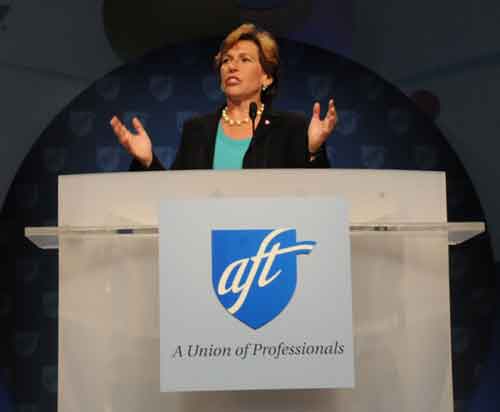 AFT President Randi Weingarten, from New York City, chaired most of the convention sessions and often relied on the fact that more than half the delegates to the convention came from New York City (Local 2, the United Federation of Teachers, who brought 750 delegates) and New York State, thereby guaranteeing that the majority of the delegates would vote in favor of resolutions Weingarten wanted even if the majority of the country disagreed. Substance photo by George N. Schmidt.Answer: Basically, the job of an AFT convention delegate is to approve of constitutional resolutions pre-selected by the leadership.
AFT President Randi Weingarten, from New York City, chaired most of the convention sessions and often relied on the fact that more than half the delegates to the convention came from New York City (Local 2, the United Federation of Teachers, who brought 750 delegates) and New York State, thereby guaranteeing that the majority of the delegates would vote in favor of resolutions Weingarten wanted even if the majority of the country disagreed. Substance photo by George N. Schmidt.Answer: Basically, the job of an AFT convention delegate is to approve of constitutional resolutions pre-selected by the leadership.
Comments:
By: WilliamKex
Unlock Holistic Wellness: Expert Guidance for a Balanced Life - Mindful Movement, Natural Skincare,
Discover the secrets to achieving optimal wellness with our expert guidance. From mindful movement and natural skincare to gut health supplements and digital detox retreats, our comprehensive resource covers it all. Learn how to prioritize your mental health, boost your energy, and nourish your body with our actionable tips and expert advice. Whether you're looking to improve your sleep hygiene, optimize your fitness routine, or simply find a sense of calm, we've got you covered. Explore our curated content and start your journey towards a balanced, holistic lifestyle today!
Fitness Goals
By: WilliamKex
Unlock Holistic Wellness: Expert Guidance for a Balanced Life - Mindful Movement, Natural Skincare,
Discover the secrets to achieving optimal wellness with our expert guidance. From mindful movement and natural skincare to gut health supplements and digital detox retreats, our comprehensive resource covers it all. Learn how to prioritize your mental health, boost your energy, and nourish your body with our actionable tips and expert advice. Whether you're looking to improve your sleep hygiene, optimize your fitness routine, or simply find a sense of calm, we've got you covered. Explore our curated content and start your journey towards a balanced, holistic lifestyle today!
Healthy Snacks


By: Jim Vail
Great article
Thank you Susan for writing a clear and excellent analysis of the AFT convention. We the first time AFT delegates learned a lot about how to shape future national union politics under the threat of total destruction by the business community and presidential administration.